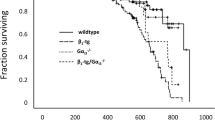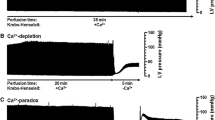Abstract
This study investigated the influence of chronic β3-adrenoceptor deficiency on myocardial function. Therefore, we investigated Ca2+-regulatory proteins, SERCA 2a activity, and myofibrillar and mitochondrial function in hearts of wild-type (WT, n=7) and β3-adrenoceptor knockout mice (β3-KNO, n=7). Morphometric heart analysis showed no difference between WT and β3-KNO. No alterations were observed for the protein expression of the ryanodine receptor or phospholamban. However, in β3-KNO mice, protein expression of SERCA 2a and phospholamban phosphorylation were significantly increased. These changes were accompanied by an increased SERCA 2a activity in β3-KNO. Alterations in phospholamban phosphorylation were independent of alterations in β1/β2-adrenoceptor distribution and protein expression of G proteins in β3-KNO. Measurement of myofibrillar Ca2+ sensitivity showed no difference in the Ca2+/force relation for WT and β3-KNO. The same seems to hold true for mitochondrial function since the protein expressions of cytochrome c, uncoupling protein 3 and cytochrome c oxidase subunit IV were similar in WT and β3-KNO. The conclusion is that depression of β3-adrenergic stimulation may modulate the protein expression of SERCA 2a and phospholamban phosphorylation, thereby improving sarcoplasmic reticulum Ca2+ uptake. Thus, β3-adrenergic depression may be a therapeutic aim in situations of impaired SERCA 2a activity, e.g. for the treatment of heart failure.





Similar content being viewed by others
References
Anger M et al (1994) In situ mRNA distribution of sarco(endo)plasmic reticulum Ca(2+)-ATPase isoforms during ontogeny in the rat. J Mol Cell Cardiol 26(4):539–550
Anger M et al (1998) Cellular distribution of Ca2+ pumps and Ca2+ release channels in rat cardiac hypertrophy induced by aortic stenosis. Circulation 98(22):2477–2486
Anwar A et al (2005) PKC-independent signal transduction pathways increase SERCA2 expression in adult rat cardiomyocytes. J Mol Cell Cardiol 39(6):911–919
Arch JR, Kaumann AJ (1993) Beta 3 and atypical beta-adrenoceptors. Med Res Rev 13(6):663–729
Arch JR, Wilson S (1996) Beta3-adrenoceptors and the regulation of metabolism in adipose tissues. Biochem Soc Trans 24(2):412–418
Arch JR et al (1984) Atypical beta-adrenoceptor on brown adipocytes as target for anti-obesity drugs. Nature 309(5964):163–165
Astrup A (2000) Thermogenic drugs as a strategy for treatment of obesity. Endocrine 13(2):207–212
Barouch LA et al (2002) Nitric oxide regulates the heart by spatial confinement of nitric oxide synthase isoforms. Nature 416(6878):337–339
Berlan M et al (1994) Beta-3 adrenoceptor-mediated increase in cutaneous blood flow in the dog. J Pharmacol Exp Ther 268(3):1444–1451
Bloch W et al (2001) Ischemia increases detectable endothelial nitric oxide synthase in rat and human myocardium. Nitric Oxide 5(4):317–333
Bradford MM (1976) A rapid and sensitive method for the quantitation of microgram quantities of protein utilizing the principle of protein-dye binding. Anal Biochem 72:248–254
Bristow MR et al (1989) Beta 1- and beta 2-adrenergic receptor-mediated adenylate cyclase stimulation in nonfailing and failing human ventricular myocardium. Mol Pharmacol 35(3):295–303
Bristow MR et al (1990) Beta-adrenergic pathways in nonfailing and failing human ventricular myocardium. Circulation 82(2 Suppl):I12–I25
Brixius K, Schwinger RH (2000) Modulation of cross-bridge interaction by 2,3-butanedione monoxime in human ventricular myocardium. Naunyn Schmiedebergs Arch Pharmacol 361(4):440–444
Brixius K et al (2001) Nebivolol, bucindolol, metoprolol and carvedilol are devoid of intrinsic sympathomimetic activity in human myocardium. Br J Pharmacol 133(8):1330–1338
Brixius K et al (2004) Mechanisms of beta 3-adrenoceptor-induced eNOS activation in right atrial and left ventricular human myocardium. Br J Pharmacol 143(8):1014–10122
Brixius K et al (2006) ß3-Adrenergic eNOS stimulation in left ventricular murine myocardium. Can J Physiol Pharmacol (in press)
Chu A et al (1988) Isolation of sarcoplasmic reticulum fractions referable to longitudinal tubules and junctional terminal cisternae from rabbit skeletal muscle. Methods Enzymol 157:36–46
Dally S et al (2006) Ca2+-ATPases in non-failing and failing heart: evidence for a novel cardiac sarco/endoplasmic reticulum Ca2+-ATPase 2 isoform (SERCA2c). Biochem J 395(2):249–258
De Lean A, Hancock A, Lefkowitz R (1982) Validation and statistical analysis of a computer modeling method for quantitative analysis of radioligand binding data for mixtures of pharmacological receptor subtypes. Mol Pharmacol 21(1):5–16
Ellison KE, Gandhi G (2005) Optimising the use of beta-adrenoceptor antagonists in coronary artery disease. Drugs 65(6):787–797
Fabiato A, Fabiato F (1979) Calculator programs for computing the composition of the solutions containing multiple metals and ligands used for experiments in skinned muscle cells. J Physiol Paris 75(5):463–505
Feldman DS et al (2005) Mechanisms of disease: beta-adrenergic receptors-alterations in signal transduction and pharmacogenomics in heart failure. Nat Clin Pract Cardiovasc Med 2(9):475–483
Galler S, Hilber K, Gobesberger A (1997) Effects of nitric oxide on force-generating proteins of skeletal muscle. Pflugers Arch 434(3):242–245
Garvey JL, Kranias EG, Solaro RJ (1988) Phosphorylation of C-protein, troponin I and phospholamban in isolated rabbit hearts. Biochem J 249(3):709–714
Gauthier C et al (1996) Functional beta3-adrenoceptor in the human heart. J Clin Invest 98(2):556–562
Gauthier C et al (1998) The negative inotropic effect of beta3-adrenoceptor stimulation is mediated by activation of a nitric oxide synthase pathway in human ventricle. J Clin Invest 102(7):1377–1384
Hasenfuss G et al (1994) Relation between myocardial function and expression of sarcoplasmic reticulum Ca(2+)-ATPase in failing and nonfailing human myocardium. Circ Res 75(3):434–442
Ji GJ et al (1999) Regulation of the L-type Ca2+ channel during cardiomyogenesis: switch from NO to adenylyl cyclase-mediated inhibition. FASEB J 13(2):313–324
Johnson M (1998) The beta-adrenoceptor. Am J Respir Crit Care Med 158(5 Pt 3):S146–S153
Karczewski P et al (1998) Phosphorylation of phospholamban correlates with relaxation of coronary artery induced by nitric oxide, adenosine, and prostacyclin in the pig. J Cell Biochem 70(1):49–59
Khan SA et al (2003) Nitric oxide regulation of myocardial contractility and calcium cycling: independent impact of neuronal and endothelial nitric oxide synthases. Circ Res 92(12):1322–1329
Kim YK et al (2003) Mechanism of enhanced cardiac function in mice with hypertrophy induced by overexpressed Akt. J Biol Chem 278(48):47622–47628
Koike K et al (1994) Involvement of beta 3-adrenoceptor in the relaxation response in guinea pig taenia caecum. Jpn J Pharmacol 66(2):213–220
Koss KL, Kranias EG (1996) Phospholamban: a prominent regulator of myocardial contractility. Circ Res 79(6):1059–1063
Lehr L et al (2004) Control of 4E-BP1 expression in mouse brown adipose tissue by the beta3-adrenoceptor. FEBS Lett 576(1–2):179–182
Liggett SB et al (1993) Structural basis for receptor subtype-specific regulation revealed by a chimeric beta 3/beta 2-adrenergic receptor. Proc Natl Acad Sci USA 90(8):3665–3669
Luo W et al (1994) Targeted ablation of the phospholamban gene is associated with markedly enhanced myocardial contractility and loss of beta-agonist stimulation. Circ Res 75(3):401–409
Maier LS et al (2005) Increased SR Ca2+ cycling contributes to improved contractile performance in SERCA2a-overexpressing transgenic rats. Cardiovasc Res 67(4):636–646
Malan D et al (2004) Nitric oxide, a key signaling molecule in the murine early embryonic heart. FASEB J 18(10):1108–1110
Meissner G, Henderson JS (1987) Rapid calcium release from cardiac sarcoplasmic reticulum vesicles is dependent on Ca2+ and is modulated by Mg2+, adenine nucleotide, and calmodulin. J Biol Chem 262(7):3065–3073
Moniotte S et al (2001) Upregulation of beta(3)-adrenoceptors and altered contractile response to inotropic amines in human failing myocardium. Circulation 103(12):1649–1655
Morimoto A et al (2004) Endogenous beta3-adrenoreceptor activation contributes to left ventricular and cardiomyocyte dysfunction in heart failure. Am J Physiol Heart Circ Physiol 286(6):H2425–H2433
Muller OJ et al (2003) Transgenic rat hearts overexpressing SERCA2a show improved contractility under baseline conditions and pressure overload. Cardiovasc Res 59(2):380–389
Munch G et al (2002) Evidence for calcineurin-mediated regulation of SERCA 2a activity in human myocardium. J Mol Cell Cardiol 34(3):321–334
Pietri-Rouxel F, Strosberg AD (1995) Pharmacological characteristics and species-related variations of beta 3-adrenergic receptors. Fundam Clin Pharmacol 9(3):211–218
Pott C et al (2003) The preferential beta3-adrenoceptor agonist BRL 37344 increases force via beta1-/beta2-adrenoceptors and induces endothelial nitric oxide synthase via beta3-adrenoceptors in human atrial myocardium. Br J Pharmacol 138(3):521–529
Rapundalo ST, Solaro RJ, Kranias EG (1989) Inotropic responses to isoproterenol and phosphodiesterase inhibitors in intact guinea pig hearts: comparison of cyclic AMP levels and phosphorylation of sarcoplasmic reticulum and myofibrillar proteins. Circ Res 64(1):104–111
Revelli JP et al (1997) Targeted gene disruption reveals a leptin-independent role for the mouse beta3-adrenoceptor in the regulation of body composition. J Clin Invest 100(5):1098–1106
Schwinger RH et al (1995) Unchanged protein levels of SERCA II and phospholamban but reduced Ca2+ uptake and Ca(2+)-ATPase activity of cardiac sarcoplasmic reticulum from dilated cardiomyopathy patients compared with patients with nonfailing hearts. Circulation 92(11):3220–3228
Shen YT, Zhang H, Vatner SF (1994) Peripheral vascular effects of beta-3 adrenergic receptor stimulation in conscious dogs. J Pharmacol Exp Ther 268(1):466–473
Simmerman HK et al (1986) Sequence analysis of phospholamban. Identification of phosphorylation sites and two major structural domains. J Biol Chem 261(28):13333–13341
Sitsapesan R, Williams AJ (1990) Mechanisms of caffeine activation of single calcium-release channels of sheep cardiac sarcoplasmic reticulum. J Physiol 423:425–439
Strosberg AD (1993) Structure, function, and regulation of adrenergic receptors. Protein Sci 2(8):1198–1209
Tada M, Toyofuku T (1996) SR Ca(2+)-ATPase/phospholamban in cardiomyocyte function. J Card Fail 2(4 Suppl):S77–S85
Ungerer M et al (1993) Altered expression of beta-adrenergic receptor kinase and beta 1-adrenergic receptors in the failing human heart. Circulation 87(2):454–463
Wallukat G (2002) The beta-adrenergic receptors. Herz 27(7):683–690
Wasson S, Fleming D, Reddy HK (2005) Evidence-based drug treatment of heart failure. Mo Med 102(6):540–548; quiz 548–549
Zhang ZS et al (2005) Enhanced inhibition of L-type Ca2+ current by beta3-adrenergic stimulation in failing rat heart. J Pharmacol Exp Ther 315(3):1203–1211
Acknowledgements
This study was supported by the Center for Molecular Medicine Cologne (CMMC, R.W.), University of Cologne. This publication contains data from the doctoral thesis of C.Z. We would like to thank Mrs. Esra Koeroglu, Mrs. Kerstin Schenk, Mrs. Nadine Lottmann and Mrs. Katja Roesler for their technical support.
Author information
Authors and Affiliations
Corresponding author
Rights and permissions
About this article
Cite this article
Ziskoven, C., Grafweg, S., Bölck, B. et al. Increased Ca2+ sensitivity and protein expression of SERCA 2a in situations of chronic β3-adrenoceptor deficiency. Pflugers Arch - Eur J Physiol 453, 443–453 (2007). https://doi.org/10.1007/s00424-006-0137-7
Received:
Accepted:
Published:
Issue Date:
DOI: https://doi.org/10.1007/s00424-006-0137-7




